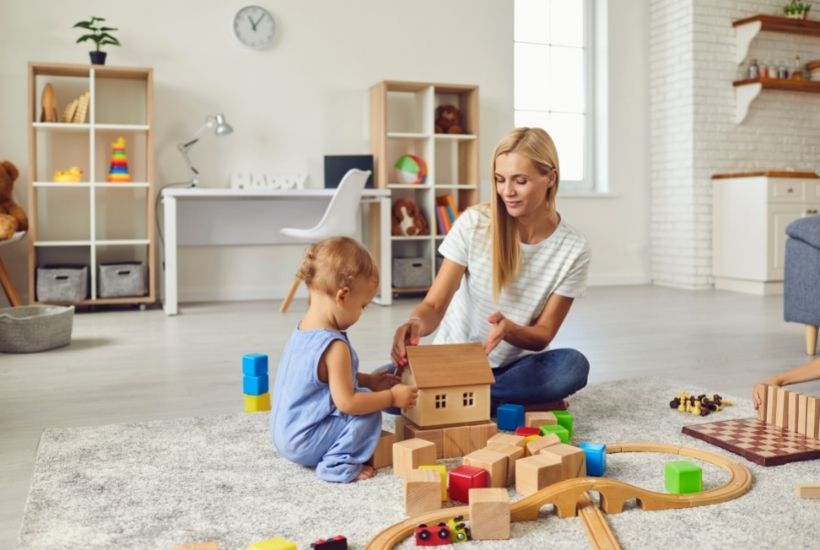11 Benefits of Construction Play in Childhood
How construction play can benefit children’s physical and mental development.
Research Shows the vast amounts of benefits of Construction play in Childhood from improving fine motor skills, to gaining mathematical concepts to gaining executive functions.
Construction play is a great activity that children enjoy as soon as they grasp things. It’s a playful way of learning where you’re child’s brain learns passively.
It teaches so many skills that by the end of this post, you will go and buy your child building blocks so that they can start to thrive.

What is construction Play?
Construction play / Manipulative play is when your child uses different objects to build and create any creation using their Imagination or instructions.
Construction play often turns into role-playing and acting as the child starts creating their imaginative worlds or enacting scenes out of their own lives.
The Benefits of Construction Play in Early Years
1) Encourages Collaborative Working
Kids can start learning about teamwork and ethics by passing a block to their co-player or sharing an idea and helping each other build it, one step at a time.
It even sets them to learn about empathy through enjoying their creation together and sharing the achievement they had together.
2) Develops Language Skills
There are so many ways to develop language skills through construction play. It starts while your kid is a toddler as you start naming the forms, shapes, and colors of the blocks your child is using.
Then by the age of 2, as they start building high towers and stacking blocks on one another, your child can learn about numbers by counting the blocks in the building.
As soon as your child can tell a story in their own words, they can start creating worlds and enacting stories from their day through the blocks.
3) Teaches Problem-Solving
Every time your child’s tower falls, The neurons in your child’s brain spark and create new connections trying to find ways to build the building in a way that doesn’t collapse and trying to learn and understand why the tower fell to learn from its mistake.
It puts your child on the path to gaining a growth mindset.
4) Sparks Creativity
Building Blocks, construction play, and open-ended play are all great and unique ways to spark creativity.
Children engage their Imagination and creativity through construction play while sparking their curiosity. Construction play is a hands-on play where children by nature, discover and explore things for themselves.
They gather information, try things, and questions while engaging in constructive play.
As Einstein said, “Imagination is more important than knowledge. Knowledge is limited. Imagination encircles the world.”
Creativity and Imagination are one of the best skills your child can develop. While doing construction play, the child is immersed in their Imagination, creating endless possibilities and wondrous worlds.
5) Introduce Mathematical Concepts
While in construction play, a child is comparing sizes and shapes, weighing things, and finding ways to create his imaginative creation, all of which help a child gain mathematical knowledge by creating patterns and developing their spatial abilities.
6) Enhances Fine Motor Skills
Fine motor skills can be seen in activities such as playing with small objects, playing with small toys, writing, and using a spoon, fork, and knife.
While doing construction play, a child needs a lot of focus and precision to create something without it collapsing, and in that way, it helps a child gain better fine motor skills.
7) Hand-Eye coordination
Children develop hand-eye coordination between the ages of six and nine. But using construction play can help their brain make sense of space and train for this unique ability.
8) Self Expression
Like creativity, a child needs to feel free to express themselves. They need to create things with no right or wrong and without guidance.
To explore and design and have a sense of proudness in what they made without us telling them how to improve it.
9) Cognitive Flexibility
Cognitive flexibility is the brain’s ability to shift activities and unplanned events, and it is sometimes called cognitive shifting.
While doing construction play, the child is exposed to lots of surprises where a shape they intended to put in place isn’t working, making them try and switch the plan. Helping them gain cognitive flexibility
10) Cause and Effect
When they try something and it doesn’t work, their brain starts to make connections and create patterns about why this didn’t work and what they need to do for it to work.
It teaches them not only flexibility but also Causes and Effect.
11) Gain Confidence in their own ability
Every time your child learns from a mistake or succeeds in building something, they understand the concept of working hard to achieve something, which helps children gain confidence in their abilities.
Adult Support in Constructive Play
- Let your child choose their own open-ended toys.
- Make it accessible for them and on eye level to feel invited to play.
- Let them make a mess – I know this might be hard, but provide a zone where they can play and let them create on their own
- Observe your child while playing to know their individual needs, what they love to play with, and how they like their toys organized
- Don’t give instructions on how to do things. Let them know that there is no wrong way to use their toys.
- Help them name things and make imaginative stories to help them gain language skills.
- Give them age-appropriate toys that will help you feel that there is no danger.
- Set up Construction Zone rules stating your rules and boundaries, such as no throwing blocks and taking turns
- Allow your child to explore
- Play with your kid
- Invite friends to play along
Example of construction play materials
- Lego
- Wooden Blocks
- Magnatiles
- Manipulative Toys
- Cardboard
- Woodworking
- Natural materials
- Sensory bins
- Puzzles
- Drawing
- Blanket Forts
- Crafting
- Making Sand Castles
- Cooking
- Clay and play dough
In general Construction, play is when your child creates something out of something else =)

How to set up a Construction Area at home
I believe every child should have the essential 5 Zones of play and a Creation Zone is one of those important zones that will help your child thrive and keep media away.
Try to create a creation Zone where you can gather the stuff your child will need to start their creations.
For the construction area or zone, I always like it to be in a playing room, a living room, or a playing corner away from the Focus Zone with enough space to feel free to create.
- Set up easy to reach open shelves to house the toys your child might need
- Make sure there is a carpet or a table that can zone the place and make them feel comfortable as they create.
- I like to keep a garbage basket in the area so that they can feel free to throw away any scraps of paper that come out of labeling things or creating signs.
- Keep a basket of figures and animals that they can use in creating stories.
- Hang up some silks that they can use to enact characters
- Dedicate an empty surface to display their recent creations

Take Construction Play Outdoors
Reap the benefits of construction play by creating an outdoor Construction Zone.
Where you’re child can observe their surroundings, enjoy the fresh air, and feel inspired to create

They can then gather stuff to construct with from nature, such as
- Wooden sticks
- Mud
- Leaves
- Flowers
- Stones (It’s the perfect place to keep the rocks you keep finding in your child’s pocket)
- Pine Cones
- Carton
- Sand
- Water
And they can even use messy things that you wouldn’t let them do in their bedroom or living room, such as
All you’ll need to create this area are
- Heavy-duty shelves
- Small bowls or baskets to hold their collections
- A table or a carpet for them to sit and play
As you can see the benefits of Construction play are endless and it can be enjoyed up until adulthood.
I hope you enjoyed this post and are looking forward to setting up your child’s creation Zone.






